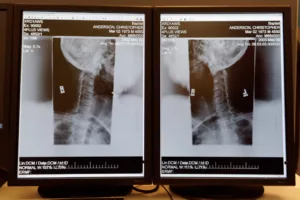Dome had a split booth. On one, the company was showing Dome@Home solutions – PC and monitor combinations that could be calibrated and certified for diagnostic applications but which are designed for use by doctors at home. Often, they want to avoid the time loss (and sometimes cost) of going to a hospital to use a certified display. The company certifies the monitors with particular PCs and docking stations, although it doesn’t sell the PCs. The main difference with the main displays is that these extra displays can be calibrated on an “as-needed” basis, rather than needing regular calibration. Automatic calibration is one of the main features for Dome which claims to have been the first company to introduce flat panel medical displays in 1999.
Moving to the main stand, we saw the Dome S3 LED which is a 3 megapixel display which is an upgrade to the previous version to include LED backlights. As well as reduced power, the new backlight improves contrast.
We had an interesting conversation about the issue of interfaces. There are real decisions to be made about interfaces, especially in multi-modality displays which need to show video in surgical applications. In this application, latency has to be very short for the main display although repeater displays can lag. There are real questions about whether compressed or uncompressed video needs to be supported and whether technology such as AVB over ethernet will become the standard. On the one hand these technologies are developing, but medical applications such as laparoscopy are taking advantage of UltraHD technology and that will push resolution and bandwidth demands up. IT interfaces may use light compression such as DisplayStream, but there are real questions of whether this would be allowed in medical applications. Certainly, the implications would need to be considered.
Dome has a new 2 megapixel colour display, the 2C LED. Although Western Europe is not so interested in this kind of resolution, Dome sees good demand from Russia and Turkey for this class of display. It sees continuing demand for multiple 3 megapixel displays, rather than a switch to 6 megapixel as “customers expect one big one to be cheaper than two smaller ones”, but this is not the case.
Dome still sees demand for dual 3 megapixel displays rather than single 6 megapixel displays
Dome has stopped supplying 10 megapixel displays as the panels are no longer available and is evaluating 8 megapixel. Dome supplies surgical as well as radiography displays and sees a continued convergence to a single display for all applications. 14 megapixel displays may be interesting, but the question is, can the systems deliver data that is really useful to the display? Image capture is rapidly improving in resolution, but it has to be delivered to the display in a standardised and controlled way.

